 “Now, folks, if we push on, we can be in Apache Wells by sundown. . . . Then it’s only a hoot and a holler into Lordsburg. We got four men who can handle firearms—five with you, Ringo. Doc can shoot if sober.” — Marshal Curly Wilcox
“Now, folks, if we push on, we can be in Apache Wells by sundown. . . . Then it’s only a hoot and a holler into Lordsburg. We got four men who can handle firearms—five with you, Ringo. Doc can shoot if sober.” — Marshal Curly Wilcox
Like a number of other films in Hollywood’s greatest year, 1939, Stagecoach has a number of distinctions that makes it one of the great American films—of America and in the spirit of Americana, drawing upon folklore and becoming, itself, a part of movie folklore. While forever regarded as a “B” Western, mainly because of its low budget, it’s a label deemed unfair by many. It’s much more than a “B” Western.
Stagecoach is director John Ford’s first sound Western, since at least two silent films, The Iron Horse (1924) and 3 Bad Men (1926), are of some distinction. One of his greatest Westerns, period, Stagecoachis the first of seven he would film in Monument Valley. “My favorite location,” he said in a 1964 interview. “I feel at peace there. I have been all over the world, but I consider this the most complete, beautiful and peaceful place on earth.” Cheyenne Autumn (1964) would be his last Western, and the last filmed in the Valley.
 This area of the eastern Utah-Arizona border became Ford’s trademark, and for a while respected as his personal property until other directors began borrowing the landscape. The backdrop of Stagecoach’s main title is, in fact, Monument Valley, behind alternate views of Indian horsemen and the U.S. Cavalry on the move. Then, the credits concluded, the evocative prehistoric stillness is broken by two men on horseback moving, though distantly, toward Bert Glennon’s camera. Glennon shot a variety of Ford movies, including The Prisoner of Shark Island (1936), The Hurricane (1937) and Rio Grande (1950). The stagecoach will traverse the Valley at least three times during the film.
This area of the eastern Utah-Arizona border became Ford’s trademark, and for a while respected as his personal property until other directors began borrowing the landscape. The backdrop of Stagecoach’s main title is, in fact, Monument Valley, behind alternate views of Indian horsemen and the U.S. Cavalry on the move. Then, the credits concluded, the evocative prehistoric stillness is broken by two men on horseback moving, though distantly, toward Bert Glennon’s camera. Glennon shot a variety of Ford movies, including The Prisoner of Shark Island (1936), The Hurricane (1937) and Rio Grande (1950). The stagecoach will traverse the Valley at least three times during the film.
In Stagecoach, Ford delineates the dangers for a group of disparate, and often desperate, passengers in a cross-country trip by stage. For the Mormons in Wagon Master (1950), the means of transportation is covered wagons as they encounter stranded travelers, a lovely damsel, the expected bad guys and, of course, Indians. Men move about mainly on horses in The Searchers (1956), both the isolated settlers and a lone horseman from the past who comes calling at a small prairie dwelling.
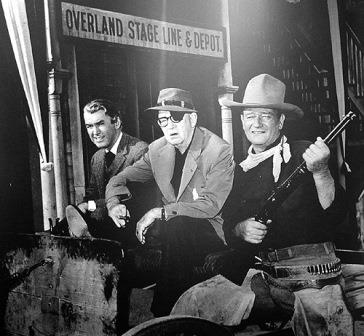 The West Ford portrays in these last three films had largely faded by 1962’s The Man Who Shot Liberty Valance, where the critical means of transportation, the railroad, symbolizes both the civilizing of the frontier and the annihilation of the West as folklore. The film represents a darkening of the director’s view of his beloved West, and, mostly set-bound, Liberty is the only one of these four films not shot, partly or entirely, in Monument Valley.
The West Ford portrays in these last three films had largely faded by 1962’s The Man Who Shot Liberty Valance, where the critical means of transportation, the railroad, symbolizes both the civilizing of the frontier and the annihilation of the West as folklore. The film represents a darkening of the director’s view of his beloved West, and, mostly set-bound, Liberty is the only one of these four films not shot, partly or entirely, in Monument Valley.
The mention of John Ford implies, for all time it seems, John Wayne. After seeing Wayne in Howard Hawks’ Red River (1948), Ford said, “I never knew the big son of a bitch could act.” It was a typical “compliment” of the often cruel, sadistic director, and Wayne was, for him, a lifelong whipping boy. Beyond the verbal abuse was a deeply embedded affection, and they made twenty-four films together, though, granted, not all are Westerns. Wayne made a total of over eighty in the genre during his career, which began in 1926—not with a Western, however—and ended in 1976 with The Shootist, a Western which portrayed a West that, finally and irrevocably, had disappeared.
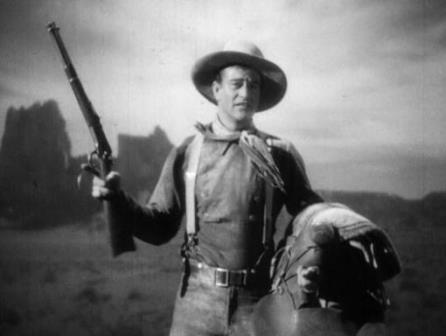 After years of making down-in-the dust “B” Westerns for Monogram and Mascot Pictures, though sometimes appearing in minor roles in “A” movies, Wayne made Stagecoach at “only” thirty-two, launching his career. Even in Stagecoach, he takes second billing to Claire Trevor, the highest paid star in a cast that includes Thomas Mitchell, Andy Devine, John Carradine, Tim Holt, Hank Worden and Jack Pennick. Most would become part of Ford’s stock company of favorite supporting players.
After years of making down-in-the dust “B” Westerns for Monogram and Mascot Pictures, though sometimes appearing in minor roles in “A” movies, Wayne made Stagecoach at “only” thirty-two, launching his career. Even in Stagecoach, he takes second billing to Claire Trevor, the highest paid star in a cast that includes Thomas Mitchell, Andy Devine, John Carradine, Tim Holt, Hank Worden and Jack Pennick. Most would become part of Ford’s stock company of favorite supporting players.
Stagecoach is an early version of The High and the Mighty (1954), Airport (1970), The Poseidon Adventure (1972), Murder on the Orient Express (1974) and many other films where a cross-section of society endures, and usually survives, possible peril on a long journey. Or, in the likes of Grand Hotel(1932) and Separate Tables (1958), the location may be stationary, and while not necessarily implying physical danger, the equally confined occupants encounter their various phobias, anxieties and jealousies.
 In the 1880s, six individuals board a stage in Arizona Territory for Lordsburg in New Mexico Territory. Although, even by that time, the characters were time-worn clichés, the actors are so perfectly cast and their performances so polished that all handicaps are overcome. It helped that Ford often scripted his films knowing in advance who would play the parts and matched the actors with the characters accordingly.
In the 1880s, six individuals board a stage in Arizona Territory for Lordsburg in New Mexico Territory. Although, even by that time, the characters were time-worn clichés, the actors are so perfectly cast and their performances so polished that all handicaps are overcome. It helped that Ford often scripted his films knowing in advance who would play the parts and matched the actors with the characters accordingly.
The main title is typically Fordian, full of American folks songs. The tunes are “Bury Me Not on the Lone Prairie” and “Jennie with the Light Brown Hair,” with alternating views of Apache (actually Navajo) horsemen and the U.S. Cavalry on the move—and Indian drum-like music. These and other such tunes will support most of the score.
When stagecoach driver Buck (Devine) informs the town marshal, Curley Wilcox (George Bancroft), that the shotgun guard is off tracking down the Ringo Kid (Wayne), who has escaped prison and is searching for Luke Plummer (Tom Tyler), the murderer of his father and brother, Wilcox volunteers to ride shotgun.
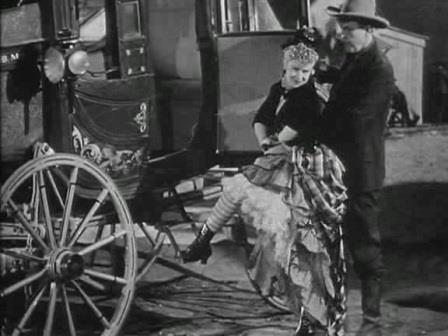 First of the passengers to board is a prostitute, Dallas (Trevor). Being chased out of town by the ladies’ Law and Order League, she asks alcoholic physician Doc Boone (Mitchell) if the ladies can force her to leave. Boone, who can’t pay his rent and has abandoned his office, says “We are the victims of a foul disease called social prejudice, my child.”
First of the passengers to board is a prostitute, Dallas (Trevor). Being chased out of town by the ladies’ Law and Order League, she asks alcoholic physician Doc Boone (Mitchell) if the ladies can force her to leave. Boone, who can’t pay his rent and has abandoned his office, says “We are the victims of a foul disease called social prejudice, my child.”
Arm in arm, they walk to the waiting stage, accompanied by one of John Ford’s favorite hymns, “Shall We Gather at the River?” Usually rendered at his frequent movie funerals, it now appears in the soundtrack as a comic march, both a little risqué and slightly tipsy.
Also making the journey are whiskey salesman Samuel Peacock (Donald Meek) and a snobbish Easterner, the pregnant Lucy Mallory (Louise Platt), on the way to meet her military husband.
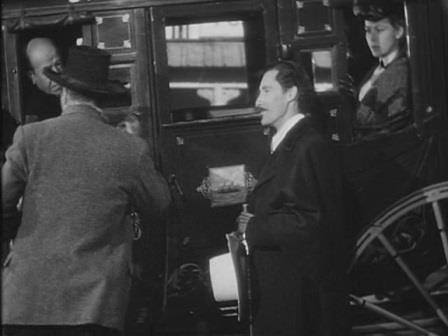 At the last moment, a Southerner, Hatfield (Carradine), boards after what he interprets as an inviting smile from Lucy. Later, when Boone refers to his medical service in the recent Civil War as the “War of the Rebellion,” Hatfield corrects him: it is the “War for the Southern Confederacy.”
At the last moment, a Southerner, Hatfield (Carradine), boards after what he interprets as an inviting smile from Lucy. Later, when Boone refers to his medical service in the recent Civil War as the “War of the Rebellion,” Hatfield corrects him: it is the “War for the Southern Confederacy.”
A cavalry unit led by Lieutenant Blanchard (Holt) arrives with news that Geronimo and the Apaches are on the warpath and that they will escort the stage to Lordsburg. “Bury Me Not on the Lone Prairie” is the leitmotiv for shots of the stage crossing the landscape.
At the edge of town, banker Ellseworth Gatewood (Berton Churchill) flags down the stage. He has stolen $50,000 from his own bank.
Further along the trail—eighteen minutes into the film—the Ringo Kid greets the stage with a single rifle shot. (Although the scene is obviously in brush country, possibly Chatsworth, Los Angeles, the first view of Wayne twirling his rifle—a rapid tracking shot, ending in a close-up—is filmed against a process screen of Monument Valley.) Ringo’s horse has gone lame. Marshal Wilcox arrests him and asks for his rifle. “You may need me and this Winchester,” Ringo says. “Saw a ranch burin’ last night.” He surrenders his rifle and sits on the floor of the already full coach.
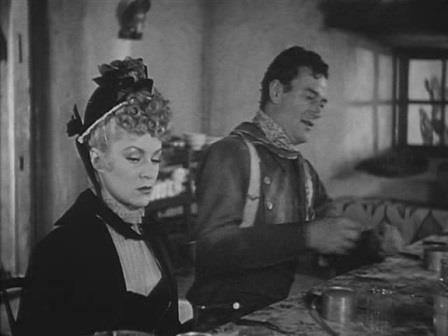 At a stopover at Dry Fork, Mrs. Mallory resents eating with a prostitute, but Ringo sits beside Dallas. Mrs. Mallory, Hatfield and Gatewood move to the other end of the table. En route to Apache Wells, Mrs. Mallory further snubs Dallas’ concern for her health. Hatfield offers her some water, but instead of giving her the canteen Wilcox passes down from the driver’s seat, he fills his folding silver cup for her. Yet when Dallas asks for water, Hatfield extends the canteen. So much for this Southern “gentleman.”
At a stopover at Dry Fork, Mrs. Mallory resents eating with a prostitute, but Ringo sits beside Dallas. Mrs. Mallory, Hatfield and Gatewood move to the other end of the table. En route to Apache Wells, Mrs. Mallory further snubs Dallas’ concern for her health. Hatfield offers her some water, but instead of giving her the canteen Wilcox passes down from the driver’s seat, he fills his folding silver cup for her. Yet when Dallas asks for water, Hatfield extends the canteen. So much for this Southern “gentleman.”
At Apache Wells, Mrs. Mallory learns that her husband has been wounded in battle and taken to Lordsburg. She faints, inducing labor, and through his drunken stupor, Doc Boone delivers a baby girl. Ringo asks Dallas to marry him. She doesn’t reply, but the next morning she accepts. Not wishing to leave Mrs. Mallory and the baby, she tells Ringo she’ll stay and meet him later.
Ringo escapes, but when he sees smoke signals, he returns to warn the stage passengers, who re-board and, now without the escorting cavalry unit, reach Lee’s Ferry. The Apaches have killed the station-keeper and his family. After crossing a river and believing they are safe, the travelers are attacked by the Indians. An arrow enters the coach and strikes Peacock.
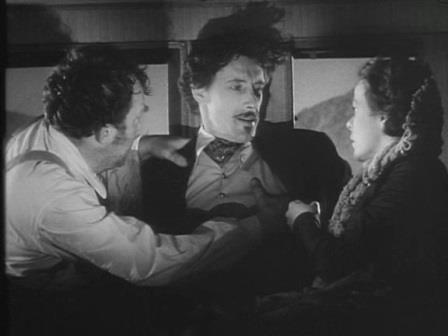 During the seven minutes as the Indians chase the coach, Buck is wounded and everyone soon runs out of ammunition. Just as Hatfield is preparing to shoot Mrs. Mallory to spare her a ghastly death from the Indians, he is fatally shot. At this moment the U.S. Sixth Cavalry arrives, and the stage continues on safely to Lordsburg.
During the seven minutes as the Indians chase the coach, Buck is wounded and everyone soon runs out of ammunition. Just as Hatfield is preparing to shoot Mrs. Mallory to spare her a ghastly death from the Indians, he is fatally shot. At this moment the U.S. Sixth Cavalry arrives, and the stage continues on safely to Lordsburg.
The stagecoach chase would justify an exciting, fitting climax. What could be better? But John Ford must tie up the many loose ends in the remaining twenty minutes of film. First, Mrs. Mallory learns her husband’s wounds are not serious and she thanks Dallas for taking care of her baby. Peacock, who survived the arrow, invites everyone to his home in Kansas City. Gatewood is arrested. And Dallas, who hasn’t told Ringo about what she does for a living, leads him to her part of town. He still wants to marry her.
But Ringo has one last thing to do. Reminiscent of the central shootout in The Man Who Shot Liberty Valance—both at night—Ringo walks down the street toward Luke Plummer and his two brothers (Vester Pegg and Joe Rickson). Their slow, edgy strides are underpinned by some actual original music. As Ringo drops to the ground to fire, the film cuts to Dallas and only shots are heard. “Ringo! Ringo! Ringo!” she cries. Ford temporarily misleads the audience and shows an apparent triumphant Luke entering the saloon, only to collapse dead on the floor. Ringo has killed all three of the Plummers.
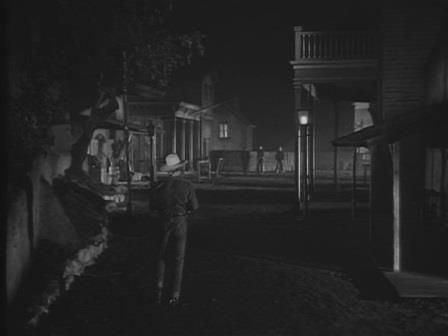 Ringo, having given his word not to escape and expecting to end up in prison, returns to Wilcox. Boone and Wilcox are waiting with a buckboard. After Ringo has said good-bye to Dallas, the marshal suggests she might “like to ride a ways with the Kid.” After Dallas climbs aboard, Boone and Wilcox throw rocks at the horses and shout, sending the two animals off at a gallop and giving Ringo his freedom and a presumed happy life with Dallas.
Ringo, having given his word not to escape and expecting to end up in prison, returns to Wilcox. Boone and Wilcox are waiting with a buckboard. After Ringo has said good-bye to Dallas, the marshal suggests she might “like to ride a ways with the Kid.” After Dallas climbs aboard, Boone and Wilcox throw rocks at the horses and shout, sending the two animals off at a gallop and giving Ringo his freedom and a presumed happy life with Dallas.
The signature trademark of Stagecoach is not the long coach chase by the Indians, however exciting and epoch-making it may be, but by its central stunt. Yakima Canutt has two “performances” in the sequence. In the more famous one, dressed as an Indian, he leaps from a running horse to the lead pair of animals in a six-horse team. He is “shot” by Ringo, falls, grasps the harness and drags his feet between the two lead horses. Ringo shoots again. Canutt lets go of the harness and the horses and coach pass over him.
In his own words:
You have to run the horses fast (35- to 37 m.p.h.), so they’ll run straight. If they run slow, they move around a lot. When you turn loose to go under the coach, you’ve got to bring your arms over your chest and stomach. You’ve got to hold your elbows close to your body, or that front axle will knock them off.
After the coach passes over him, he attempts to stand up, then falls and remains inert, to show a dummy hadn’t been used. From the flat plain of Lucerne Dry Lake in the Mojave Desert, Canutt selected the hardest part, so that the coach wheels would sink as little as possible into the surface.
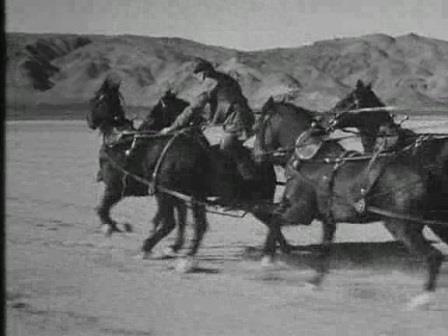 Of course, there’s the obvious question few viewers of Stagecoach seem to ask, one that exposes an obvious inaccuracy: Why didn’t the Apaches simply shoot the horses?! “If they did that,” Ford once replied, “the picture would be over.”
Of course, there’s the obvious question few viewers of Stagecoach seem to ask, one that exposes an obvious inaccuracy: Why didn’t the Apaches simply shoot the horses?! “If they did that,” Ford once replied, “the picture would be over.”
English theater critic and writer Kenneth Tynan asked Orson Welles in 1967 which directors he most admired. “The old masters,” he famously replied. “By which I mean John Ford, John Ford and John Ford.” If not compliment enough, Welles showed his high esteem for Ford by, he said, viewing Stagecoach forty times before beginning Citizen Kane (1941). Ford’s influence is clearly seen in many aspects of Welles’ film, including those “original” shots of ceilings.